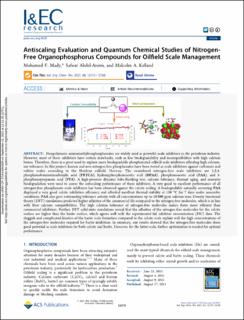| dc.contributor.author | Mady, Mohamed Fawzy Hamed Attia | |
| dc.contributor.author | Abdel-Azeim, Safwat | |
| dc.contributor.author | Kelland, Malcolm A. | |
| dc.date.accessioned | 2021-10-19T09:04:59Z | |
| dc.date.available | 2021-10-19T09:04:59Z | |
| dc.date.created | 2021-09-22T09:32:59Z | |
| dc.date.issued | 2021-08 | |
| dc.identifier.citation | Mady, M.F., Abdel-Azeim, S., Kelland, M.A. (2021) Antiscaling Evaluation and Quantum Chemical Studies of Nitrogen-Free Organophosphorus Compounds for Oilfield Scale Management. Industrial & Engineering Chemistry Research, 60(33), 12175–12188 | en_US |
| dc.identifier.issn | 0888-5885 | |
| dc.identifier.uri | https://hdl.handle.net/11250/2823816 | |
| dc.description.abstract | Nonpolymeric aminomethylenephosphonates are widely used as powerful scale inhibitors in the petroleum industry. However, most of these inhibitors have certain drawbacks, such as low biodegradability and incompatibilities with high calcium brines. Therefore, there is a great need to explore more biodegradable phosphonated oilfield scale inhibitors affording high calcium-ion tolerance. In this project, known and new nitrogen-free phosphonates have been tested as scale inhibitors against carbonate and sulfate scales according to the Heidrun oilfield, Norway. The considered nitrogen-free scale inhibitors are 1,2,4-phosphonobutanetricarboxylic acid (PBTCA), hydroxyphosphonoacetic acid (HPAA), phosphonoacetic acid (PAA), and 3-phosphonopropanoic acid (PPA). A high-pressure dynamic tube-blocking test, calcium tolerance, thermal aging, and seawater biodegradation were used to assess the antiscaling performance of these inhibitors. A very good to excellent performance of all nitrogen-free phosphonate scale inhibitors has been observed against the calcite scaling. A biodegradable naturally occurring PAA displayed a very good calcite inhibition efficiency and afforded excellent thermal stability at 130 °C for 7 days under anaerobic conditions. PAA also gave outstanding tolerance activity with all concentrations up to 10 000 ppm calcium ions. Density functional theory (DFT) simulations predicted higher affinities of the commercial SIs compared to the nitrogen-free molecules, which is in line with their calcium compatibilities. The high calcium tolerance of nitrogen-free molecules makes them more efficient than commercial inhibitors. Further, DFT solid-state simulations reveal that the affinities of the nitrogen-free molecules for the calcite surface are higher than the barite surface, which agrees well with the experimental fail inhibitor concentration (FIC) data. The sluggish and complicated kinetics of the barite scale formation compared to the calcite scale explain well the high concentrations of the nitrogen-free molecules required for barite inhibition. In summary, our results showed that the nitrogen-free molecules show good potential as scale inhibitors for both calcite and barite. However, for the latter scale, further optimization is needed for optimal performance. | en_US |
| dc.language.iso | eng | en_US |
| dc.publisher | American Chemical Society | en_US |
| dc.rights | Navngivelse 4.0 Internasjonal | * |
| dc.rights.uri | http://creativecommons.org/licenses/by/4.0/deed.no | * |
| dc.subject | kjemi | en_US |
| dc.subject | olje- og gassnæringen | en_US |
| dc.title | Antiscaling Evaluation and Quantum Chemical Studies of Nitrogen-Free Organophosphorus Compounds for Oilfield Scale Management | en_US |
| dc.type | Peer reviewed | en_US |
| dc.type | Journal article | en_US |
| dc.description.version | publishedVersion | en_US |
| dc.rights.holder | © The Authors 2021 | en_US |
| dc.subject.nsi | VDP::Matematikk og Naturvitenskap: 400::Kjemi: 440 | en_US |
| dc.subject.nsi | VDP::Teknologi: 500::Berg‑ og petroleumsfag: 510::Petroleumsteknologi: 512 | en_US |
| dc.source.pagenumber | 12175–12188 | en_US |
| dc.source.volume | 60 | en_US |
| dc.source.journal | Industrial & Engineering Chemistry Research | en_US |
| dc.identifier.doi | 10.1021/acs.iecr.1c02441 | |
| dc.identifier.cristin | 1936936 | |
| cristin.ispublished | true | |
| cristin.fulltext | original | |
| cristin.qualitycode | 2 | |

